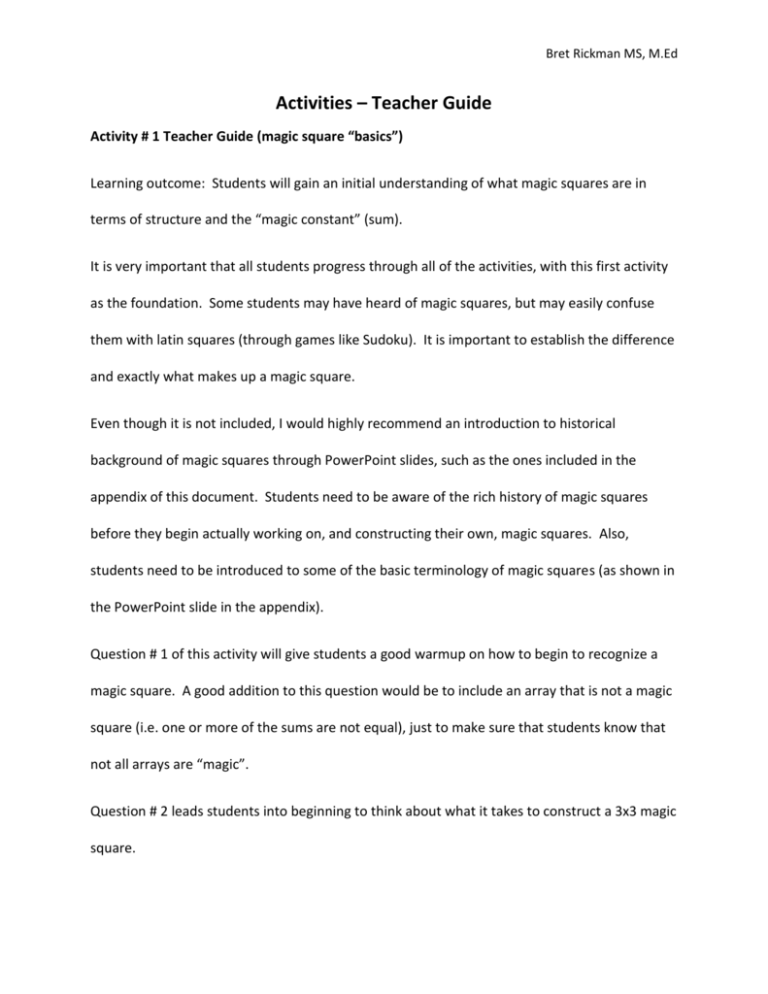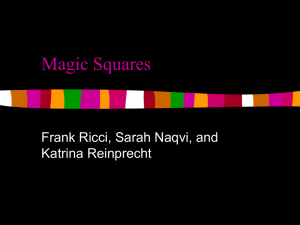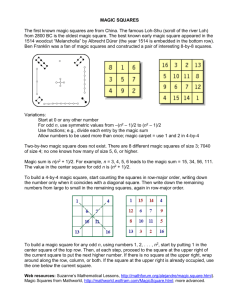Rickman Activities Teacher Guide
advertisement

Bret Rickman MS, M.Ed Activities – Teacher Guide Activity # 1 Teacher Guide (magic square “basics”) Learning outcome: Students will gain an initial understanding of what magic squares are in terms of structure and the “magic constant” (sum). It is very important that all students progress through all of the activities, with this first activity as the foundation. Some students may have heard of magic squares, but may easily confuse them with latin squares (through games like Sudoku). It is important to establish the difference and exactly what makes up a magic square. Even though it is not included, I would highly recommend an introduction to historical background of magic squares through PowerPoint slides, such as the ones included in the appendix of this document. Students need to be aware of the rich history of magic squares before they begin actually working on, and constructing their own, magic squares. Also, students need to be introduced to some of the basic terminology of magic squares (as shown in the PowerPoint slide in the appendix). Question # 1 of this activity will give students a good warmup on how to begin to recognize a magic square. A good addition to this question would be to include an array that is not a magic square (i.e. one or more of the sums are not equal), just to make sure that students know that not all arrays are “magic”. Question # 2 leads students into beginning to think about what it takes to construct a 3x3 magic square. Bret Rickman MS, M.Ed This is a fairly short activity, but is a crucial to make sure that all students have a basic understanding of magic squares before continuing to more advanced concepts. Activity # 2 Teacher Guide (beginning magic square constructions) Learning outcome: Students will better comprehend how to construct magic squares, some of the mathematics behind magic squares, and what the concept of “uniqueness” means. Questions # 1 & 2 begins with guiding students to recognize the importance of the middle element (number) of any odd order “normal” magic square (the terms “order” and “normal” need to be reinforced for students at this point). Questions # 3 will take students quite a bit of time, and there will likely be quite a few questions that students will have during this time. The concept of scalar multiplication is embedded in this question, although not explicitly mentioned. It would be good to encourage students to discover this concept (implicitly). The concept of uniqueness of a magic square is also very important during this particular question. A unique magic square is one that cannot be created by any reflection, rotation, or combination of reflection and rotation. Students need to be very clear about this distinction. I would recommend closing this activity with the precise number of possible unique magic square combinations for orders 1 – 6 as shown below (these are the only orders for which the number of unique magic squares are known): Order 1 : 1 unique magic square. Order 2 : 0 unique magic squares. Order 3 : 1 unique magic square. Bret Rickman MS, M.Ed Order 4 : 880 unique magic squares. Order 5 : 275,305,224 unique magic squares. Order 6 : (0.17745 0.00016) 1020 unique magic squares (estimated using Monte Carlo simulation by Pinn and Wieczerkowski (1998). Activity # 3 Teacher Guide (magic square constructions) Learning outcome: Students will gain a more comprehensive understanding of the complexity, and wide variation of constructions of odd order magic squares. This activity would be best connected directly with activity # 2 – as an important extension. The 3x3 arrays will be redundant, since students will have already found that there is only one unique order 3 magic square. But this fact can be reinforced here, through student discovery – and is mainly included here in case activity 2 was complete on a previous day (not immediately before activity 3). It needs to be made very clear to students that they are only creating “normal” magic squares. After students have struggled with the order 5 magic square constructions, it would be advisable to discuss the concept of the “middle number” of an odd order magic square and methods to compute this value. In addition to the computation and importance of the middle number, a discussion (discovery time for students, first) regarding why the middle number is so important along with a proof of this. Be sure to guide students to the realization (again, through discovery based learning, if at all possible) that the magic sum is three times the middle number for any odd order normal magic square. Following is an example of a proof of this fact: Bret Rickman MS, M.Ed Lemma: Row total of 3x3 magic square is 3 times its center value. Proof/discussion: The reason that the magic sum in a 3x3 magic square must be 3 times the center number is that the center is part of four different sums; two diagonals, a vertical and horizontal. We know that the sum of all the numbers is equal to the sum of 3 rows, and since the center number is used in four sums and we use three rows of sums for the total sum (including one of the “center” value), we have one row total (sum) left (the magic constant) for the three other center numbers – which must sum to one row total (again, the magic constant). Therefore the magic number (row total) is equal to three times the center number. QED I would recommend allowing students to attempt to discover this lemma on their own – and possibly guide them through a proof of this in outline form to begin with. An excellent natural progression to an easy to understand model for construction of odd order squares, would be to briefly leave the “normal” magic square and begin with a “balanced model” approach with the center number set equal to zero. This leads to the fact that the magic constant (sum) would also be zero. Beginning with the 3x3 empty array, show that the progression of the nine numeric values, with “0” as the center would begin with -4 and end with +4 as follows: -4 -3 -2 -1 0 1 2 3 4 Students would then place these values in the blank 3x3 array in any balanced form to create a magic square. Then through a scalar operation (leading to activity # 4), a multitude of magic squares can be created (non-normal, but still perfectly valid). Below is an example of a typical 3x3 “balanced construction” magic square: Bret Rickman MS, M.Ed 3 -4 1 -2 0 2 -1 4 -3 With this approach, students can easily extend this technique to order 5, 7, 9 and 11 (etc.). Another great addition to this activity is the proof of the equation for magic constant of any normal (odd or even) magic square, as follows: Given the arithmetic sequence 1 2 3 ... n n(n 1) 2 And for the arithmetic sequence, we have 1 2 3 ... n 2 n 2 (n 2 1) 2 Which leads to the following conclusion for the magic sum (must divide by the number or rows n 2 (n 2 1) n(n 2 1) to get the sum for just one row; the magic constant): . 2n 2 Lastly, a discussion of the staircase (Hindu / Loubere) method is needed, after students have spent time discovering on their own through guess and check or other methods, as a way to construct odd order normal magic squares. This technique is discuss in the body of my curriculum research project paper. Bret Rickman MS, M.Ed Activity # 4 Teacher Guide (scalar operations) Learning outcome: Students will construct new knowledge about “closure”, beginning with scalar operations with magic squares. Group work needs to be strongly encouraged, especially in this and all of the following activities. With this activity, depending on students’ cognitive development stage, it would be good to have a discussion with students about the concept of closure with regard to operations. I would suggest having this open ended discussion after students have completed the initial scalar operations, but before getting into page 2 of this activity. After discussing the concept of closure, then students could continue with their observations about how the magic constant is related to the scalar and operation. A very important cognitive step for students is to emphasize the need for a simple proof, when the “Explain how you know…” questions are asked on the activity sheet. The proofs are fairly simple, for instance, with the “add 2” operation we have: (2 a) (2 b) (2 c) 6 (a b c) which explains why the new magic number is “6” more than the original magic square total. Similar proofs can be performed by the students to justify their other scalar operations – leading to the next level of a “generic” scalar variable for each of the for operation proofs. This provides a very good introduction into proofs and a confidence builder for students. Bret Rickman MS, M.Ed Activity # 5 Teacher Guide (magic square associative property of addition) Learning outcome: Students will extend the concept of “closure” from merely scalar operations that were verified in the previous activity – to the broader topic of the Associative property of addition. A natural progression from activity # 4, is the concept of closure under the associative property of matrix addition with magic squares. Students will need to now handle three different arrays (which they now have the knowledge and background to generate these 3x3 magic squares) in order to verify closure for the arrays they have chosen. Both activities 4 and 5 are very good to utilize small groups of two or three students per group to not only share magic squares jointly – but also compare with the entire class to see if all of the combinations the class came up with actually verified the associative property of addition. This would lead to an excellent opportunity to discuss as a class how we could generalize our findings to “all possible” combinations of 3x3 magic squares (a more detailed proof opportunity) – immediately following, or during, the “conjecture” question at the end of the activity. Since matrix multiplication has not been introduced yet, it would be premature to attempt to prove an Associative property of Matrix Multiplication (although students will discover that matrix multiplication is not closed for full magic squares). Bret Rickman MS, M.Ed Activity # 6 Teacher Guide (magic square matrix multiplication) Learning outcome: Students will extend the previous two activities into the advanced area of matrix multiplication closure of magic squares. This activity needs to begin with an introduction of specifically how to multiply two matrices. Some students may already be aware of this operation, but many students will potentially have little or no exposure to matrix multiplication. Also this is a great way to reinforce the concept through review – plus extending it to magic squares. It would be best if students worked in small groups (possibly utilizing the Think, Pair, Share model) while working through this activity. Students will discover (by counterexample) that matrix multiplication is not closed for magic squares since either one or both diagonal sums will not match the magic constant. But, the row and column totals do match the magic sum – which leads to the opportunity to discuss what a “Semi-Magic Square” is (magic squares where only the row and column totals match). An extension to this activity would be to try and verify if the Associative Property of Matrix Multiplication is closed for “Semi-Magic Squares”.






